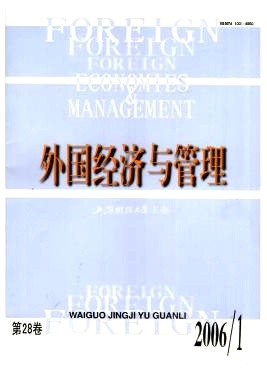双元型组织研究评介
外国经济与管理 2006 年 第 28 卷第 01 期, 页码:1 - 8
摘要
参考文献
摘要
本文以组织应对环境变革既需要开发能力也需要探索能力这一研究背景出发,指出双元型组织的管理学本质就是试图对组织悖论进行管理,总结了其主要的研究视角,分析了双元型组织结构解决组织悖论的三种途径,并且对双元型组织的特征与实证研究等进行了评述。
[1]Duncan,R B.The ambidextrous organization:designing dual structures for innovation[A].In R Kilman&L Pondy(eds.).The management of organizational design[C].New York:North Holland,1976:167-188.
[2]March,J G.Exploration and exploitation in organizational learning[J].Organization Science,1991,2:71-87.
[3]Abernathy and Clark Innovation:mapping the winds of creative destruction[J].Research Policy,1985,14:3-22.
[4]Levinthal,D A,and March J G.The myopia of learning[J].Strategic Management Journal,1993,14:95-112.
[5]Leonard-Barton,D A.Core capabilities and core rigidities:a paradox in managing new product development[J].Strate-gic Management Journal,1992,13:111-125.
[6]Levitt,D A,and March J G.Organizational learning[J].Annual Review of Sociology,1988,14:319-340.
[7]Peters,T J,and Waterman,R H.In search of excellence:lessons from America’s best run companies[M].New York:Harper and Row,1982.
[8]Eisenhardt,K M.Paradox,spirals,ambivalence:the new language of change and pluralism[J].Academy of Manage-ment Review,2000,25:703-705.
[9]Quinn,R E,and Cameron,K S.Paradox and transformation:toward a theory of change[A].In Organization and man-agement[C].Cambridge MA:MTI Press,1988.
[10]Slaatte,H A.The pertinence of paradox:the dialectics of reason-in-existence[M].New York:Humanities Press,1968.
[11]Justin J.Ambidextrous organizations:a multiple-level study of absorptive capacity,exploratory and exploitative innova-tion,and performance[D].Erasmus Research Institute of Management(ERIM),Erasmus University,Rotterdam,Inter-net:http://www.erim.eur.nl,2005.
[12]Tushman,M,and O’Reilly,C A.Evolution and revolution:mastering the dynamics of innovation and change[J].Cali-fornia Management Review,1996,38:8-30.
[13]Gibson C B,Birkinshaw J.The antecedents,consequences,and mediating role of organizational ambidexterity[J].A-cademy of Management Journal,2004,47:209-226.
[14]Birkinshaw,J,and Gibson C B.Building ambidexterity into an organization[J].MIT Sloan Management Review,2004,(sum.):47-55.
[15]O’Reilly C A,Tushman M.The ambidextrous organization[J].Harvard Business Review,2004,82:74-82.
[2]March,J G.Exploration and exploitation in organizational learning[J].Organization Science,1991,2:71-87.
[3]Abernathy and Clark Innovation:mapping the winds of creative destruction[J].Research Policy,1985,14:3-22.
[4]Levinthal,D A,and March J G.The myopia of learning[J].Strategic Management Journal,1993,14:95-112.
[5]Leonard-Barton,D A.Core capabilities and core rigidities:a paradox in managing new product development[J].Strate-gic Management Journal,1992,13:111-125.
[6]Levitt,D A,and March J G.Organizational learning[J].Annual Review of Sociology,1988,14:319-340.
[7]Peters,T J,and Waterman,R H.In search of excellence:lessons from America’s best run companies[M].New York:Harper and Row,1982.
[8]Eisenhardt,K M.Paradox,spirals,ambivalence:the new language of change and pluralism[J].Academy of Manage-ment Review,2000,25:703-705.
[9]Quinn,R E,and Cameron,K S.Paradox and transformation:toward a theory of change[A].In Organization and man-agement[C].Cambridge MA:MTI Press,1988.
[10]Slaatte,H A.The pertinence of paradox:the dialectics of reason-in-existence[M].New York:Humanities Press,1968.
[11]Justin J.Ambidextrous organizations:a multiple-level study of absorptive capacity,exploratory and exploitative innova-tion,and performance[D].Erasmus Research Institute of Management(ERIM),Erasmus University,Rotterdam,Inter-net:http://www.erim.eur.nl,2005.
[12]Tushman,M,and O’Reilly,C A.Evolution and revolution:mastering the dynamics of innovation and change[J].Cali-fornia Management Review,1996,38:8-30.
[13]Gibson C B,Birkinshaw J.The antecedents,consequences,and mediating role of organizational ambidexterity[J].A-cademy of Management Journal,2004,47:209-226.
[14]Birkinshaw,J,and Gibson C B.Building ambidexterity into an organization[J].MIT Sloan Management Review,2004,(sum.):47-55.
[15]O’Reilly C A,Tushman M.The ambidextrous organization[J].Harvard Business Review,2004,82:74-82.
引用本文
张玉利, 李乾文. 双元型组织研究评介[J]. 外国经济与管理, 2006, 28(1): 1–8.
导出参考文献,格式为:





 6466
6466  0
0

